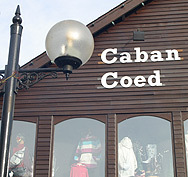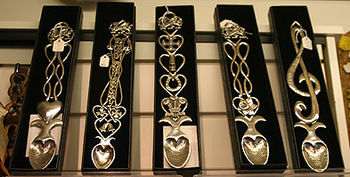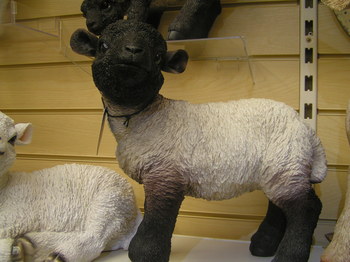Welsh Love Spoons
The custom of carving and giving Welsh Lovespoons originated in Wales hundreds of years ago. The young men of today would probably buy flowers, chocolates or jewellery as a token of affection. Centuries ago in Wales, the young lover would also give gifts of sweets or cakes; but they would also give a special, more personal gift to the object of their desire, the Welsh Love Spoon. Some of the early love spoons can be seen on display at the Welsh Folk Museum in Cardiff. There is even one that dates back to 1667.
The young man would spend hours carving the spoon with his own hands, in the hope that the girl would accept it. If the girl accepted the spoon, she would demonstrate her interest in him and they would commence on a relationship, which is the origin of the word 'spooning'.
Young men had a lot of time on their hands during the long winter evenings, and while some would turn to poetry or composing songs, others would carve all kinds of things such as kitchen utensils or toys for the children from spare pieces of wood.
It is easy to imagine a young man after a hard day's work, in a period of no radio or television or cars, spending his leisure time during dark evenings carving a spoon for the girl he loved. Spoons could also suggest food on the table, and a cosy family life, which would impress on the girl his ability to care for her and a family.

This information has been kindly supplied by Cadwyn Ltd, Dolwerdd, Llanfihangel ar Arth, Cymru/Wales, 01559 384378, e-mail Click to email Website: website link
This was a custom that was not confined to Wales, but happened across Europe, especially in Celtic countries. Because the rural peasant people used wooden spoons to eat and prepare food, they had to carve numerous simple spoons for this purpose. It is very likely therefore that more intricate carvings developed naturally from this, and the most beautiful spoons were kept to give as gifts.
The greatest authority on the tradition of carving Welsh Love Spoons in Wales today is Gwyndaf Breeze. According to Gwyndaf, who taught the craft to Paul Curtis (the main craftsman responsible for the Cadwyn Ltd range of Love Spoons), although the tradition of carving lovespoons is not unique to Wales, the quality of those produced here is among the best in the world, and the development of the spoon from a common kitchen utensil to the intricately carved design is an uniquely Welsh phenomenon.
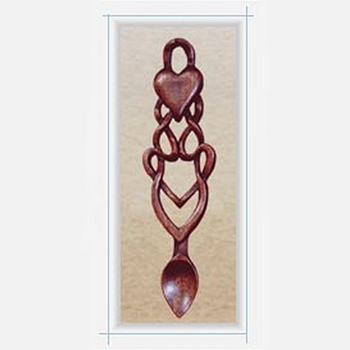
No other country in the world produced such a variety of design and carving techniques; and the young men put a great deal of time and thought into their creations. Wales was a poor society whose youth could not afford presents of expensive jewellery, and therefore they would do their utmost to create as beautiful spoons as possible.
At that time, practical skills in a husband would have been very desirable and a beautifully carved spoon would demonstrate the young man's skills. The carvers would attempt to create more and more intricate designs as they vied for the attractions of a certain girl. The more complicated and difficult to carve a design, the more it would symbolise the depth of the creator's love and desire to labour on behalf of his loved one. It is also possible that the size of the spoon would reflect the carver's love, but the spoons do vary considerably in size from 8cm to a meter in length.
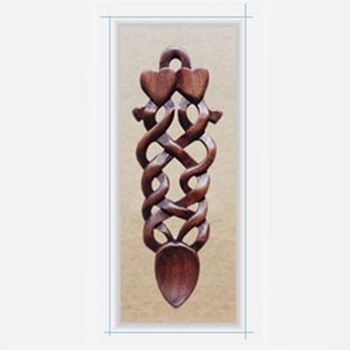
The first example of the word "llwy" (which is 'spoon' in Welsh) appears in the work of Taliesin, the 6th century Welsh poet, which suggests that such a utensil existed for centuries before the first existing tangible example. Wooden utensils used in kitchens would not have a very long life and very few original wooden work utensils have survived from a period earlier than the 18th century.
The custom was widespread across Wales and there is no evidence to suggest that certain areas favoured certain designs. It is impossible to know how many love spoons were produced; many were very delicate creations and although they would not have been used for eating or cooking they could have been easily broken. The earliest existing examples come from the 17th century, and it is possible that the shape of spoons lying together suggested the pattern of lovers lying together.
There has been much debate on the significance of the different symbols and motifs used in the carving of lovespoons. Many of the young carvers were shy and unwilling to show their emotions, and this would attempt to convey their true feelings through the use of various symbols. Over the centuries, many more symbols and motifs have been added and as the love spoons became more elaborate and decorative, they have become collectables.
Many of the symbols to convey love have been used from the earliest spoons, and are familiar throughout Europe. For instance, a chain would mean a wish to be together forever, a diamond would mean wealth or good fortune, a cross would mean faith, a flower would mean affection, or a dragon for protection etc. Click here to see a list of many symbols that are frequently carved into Love Spoons.
Traditionally, the spoons were carved from one piece of wood. The most popular wood was sycamore, but we also have examples of using yew, oak, boxwood and even fruit trees such as apple or wild cherry. Wood with a close grain had to be dried because fresh wood could split as it dried. The carver would use a trunk and split it in half before forming the rough shape of the spoon in one of the halves.
The earliest spoons were not very intricate, and would have a very simple design with perhaps the initials of the couple and a hole of some sort in the top of the spoon handle to hang it on the wall. These early carvers would use very simple tools, only a pocketknife, an axe and perhaps a saw. They had no design to follow or any technical knowledge; although they perhaps copied other designs and some of their creations are remarkable in these circumstances.
If the young man succeeded in capturing the girl's heart, then the spoon would be treasured and proudly displayed on one of the walls of their home, much as a wedding photograph would be today. It is quite possible also, that a particularly popular girl would receive several spoons from would-be suitors; but it is unlikely that a youth would spend too much time and effort if he did not think he had a realistic chance of winning the girl. When a girl accepted the spoon, the young people would more than likely then embark on a relationship and be seen as a 'couple' by their community.
It must be remembered that the custom of 'engaging' and having a Wedding ceremony was not common in rural Wales until the end of the 18th century, and the majority of young couples would simply co-habit.
Today as well as being a gift of affection or a memento of a visit to Wales, Lovespoons are given for many special occasions such as weddings, birthdays, anniversaries, births, engagements, christenings, house warming and St. Valentines Day.
Each Symbol has a different Meaning! - There has been much debate on the significance of the different symbols and motifs used in the carving of lovespoons. Many of the young carvers were shy and unwilling to show their emotions, and this would attempt to convey their true feelings through the use of various symbols. Over the centuries, many more symbols and motifs have been added and as the love spoons became more elaborate and decorative, they have become collectables.
BELL Weddings or Anniversaries or Together in Harmony.
BALL IN CAGE Love held safe or number of children.
BIRDS Love birds or Lets go away together.
CHAIN A wish to be together forever or, Number of children.
CROSS A wish to have faith in Christ Jesus or, A wish to be bound together in Christ or A wish for God to bless.
DIAMOND Wealth or Good fortune.
HEART Love.
HORSESHOE Good luck
KEY/ KEYHOLE Security or I shall look after you.
KNOT / CELTIC KNOTWORK Eternal love or Together forever or Everlasting.
LOCK Security or, I shall look after you
TWISTED STEM Two live become as one, or, Togetherness.
DRAGON Protection or Symbol of Wales.
Welsh Love Spoons Statistics: 0 click throughs, 1307 views since start of 2025
